A quick look through retailers of school chairs and desks failed to find any models that had the slightest regard for ergonomics. Astonishing! Especially as this may be where adult LBP begins.
School chairs
This post is not intended to be authorative on children’s and school seating. In view of the importance of the subject a few points arise from the spinal biomechanics .
It would seem that non-western populations that do not habitually sit in upright chairs have a low, or no, incidence of LBP and are able to squat and sit slumped. It has been shown that they have a larger sacral-horizontal angle and a larger lumbo-sacral (L5/S1) angle which, safely, does not reduce below 0° on flexion (see. ‘Angles & lordosis). This may partially represent a racial genetic advantage but cannot be the whole story as the same people incur the same incidence levels of LBP when the upright sitting posture is adopted in childhood. This suggests that adverse mid- upright sitting postures in childhood modifies the spinal bio-mechanics and so may determine future liability to LBP. Early stretching of the posterior elements of the motion segment which, in turn allows spinal joint instability and early disc degeneration (see CTD ) is likely. It may even be the fundamental cause. More research is required.
On this assumption, school chairs or chair/desk combinations should be properly designed to ensure, as far as is possible, bio-mechanical optimisation. This can be done at no great cost using a FTS tilting seat and a back rest with Iliac support in a height adjustable desk/chair unit. In theory, at least, this would avoid the stretching of the posterior stabilising ligaments. Some positional instability allows movement which aids the pumping action of position changes for the nutrition of the IV disc, also a factor helping to avoid later degenerative changes.
There are some general childhood requirements:-
- Sturdiness so as to withstand a childs natural curiosity to test to destruction.
- Allow freedom of movement for small children with short attention spans.
- Absence of any holes and crannies into which fingers or other objects can be stuck.
School and schoolroom requirements
- Cost considerations
- Stackability.
The essential bio-mechanical requirements for school chairs are the same as for an adult:-
- A forward tilted seat
- or/and Iliac support.
- Height adjustability of desk & chair.
- Avoidance of, commonly advised, incorrect systems.
- A 2T chair is hardly practical in a school environment, but not at home.
- The requirements for a school chair/desk may be different from those of a small child. Small children seem to enjoy and do well on a large ball. This ensures a FTS, freedom of movement and seems to be safe.
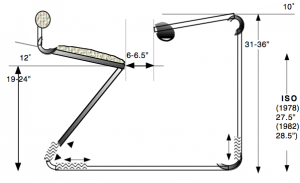 My ‘off the cuff’ idea of a design for a school chair and desk combination. →
My ‘off the cuff’ idea of a design for a school chair and desk combination. →
Note that these measurements are considerably greater than the ISO recommendations – it is difficult to understand on what the latter measurements were based.
←I was amazed to see something almost identical on eBay although possibly intended for adults and not much ‘Adjustment’. I tend to decry adjustment for adult seating See → Adjustments .
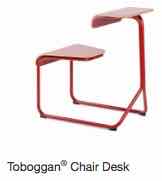 Another chair by Knoll for adults seems relevant.
Another chair by Knoll for adults seems relevant.
An existing good start, for consideration, is a model from the German firm MOLL. The design suggests that it still subscribes to the outworn ‘correct’ upright sitting concept. This may be a necessary constraint.
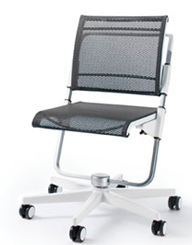
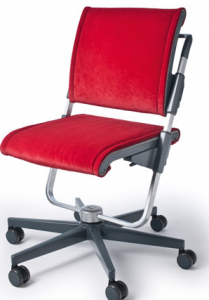 ⟵ The ‘Scooter’ is the simplest and, possibly, best.
⟵ The ‘Scooter’ is the simplest and, possibly, best.- Adjusts easily to the growing size of the child.
- Allows movement. Absence of arm-rests may help here.
- A FTS to allow the hip angle to be “slightly open (more than 90°)”. Ideally should be greater, to 130°.
- Some degree of pelvic support. Could be improved.
A quick look through retailers of school chairs and desks failed to find any models that had the slightest regard for ergonomics. Astonishing!
The FIRA publication is worth looking at in this respect “We as a nation are embarking upon a major investment in our schools and teaching methods – but our school furniture design has changed little from the post-war era. It’s not just about aesthetics ….This call to action comes from FIRA (Furniture Industry Research Association) in response to requests from government, purchasers, parents, teachers and children to make a change”.
http://www.fira.co.uk/document/safe-seats-of-learning.pdf
They adhere to British Standards BSEN 9241 Pt 5.
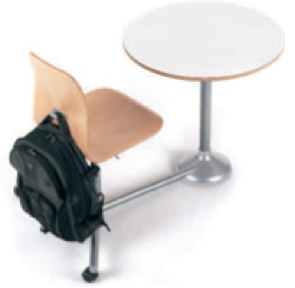 The bio-mechanics of the charming looking chair pictured on the front page seems to be as adverse as it gets. It is not clear if this is being recommended or dis-recommended. Can you spot the faults?
The bio-mechanics of the charming looking chair pictured on the front page seems to be as adverse as it gets. It is not clear if this is being recommended or dis-recommended. Can you spot the faults?
Comment
From Rani Lueder
There is a large amount of evidence that children – particularly as they approach puberty – are prone to back pain, that these symptoms can be medically established, and that their rate of pain compare with those of adults. Not that their symptoms mean the same thing as they do in adults, mind you, but they’re comparable. And children and adolescents who have symptoms are particularly prone to exhibit evidence of back symptoms later in life – that is, a decade or so later. My book is beginning to look dated at this point (there’s so much research) but unfortunately I can’t point you to a more up to date resource, it’s still the most thorough review.
Thank you, Rani
Very helpful. I must admit to being shocked when I looked at the children’s chairs being retailed, at least in the UK.
Henry
Dr Henry Sanford

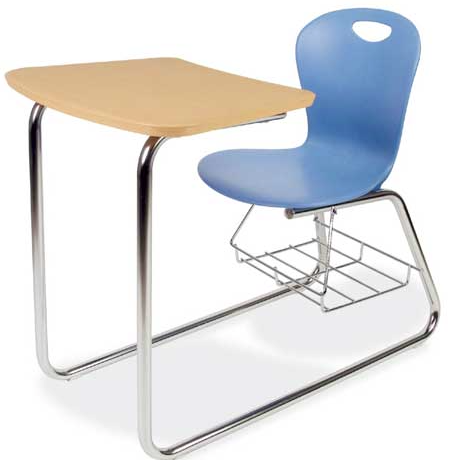
From Rani Lueder
There is a large amount of evidence that children – particularly as they approach puberty – are prone to back pain, that these symptoms can be medically established, and that their rate of pain compare with those of adults. Not that their symptoms mean the same thing as they do in adults, mind you, but they’re comparable. And children and adolescents who have symptoms are particularly prone to exhibit evidence of back symptoms later in life – that is, a decade or so later. My book is beginning to look dated at this point (there’s so much research) but unfortunately I can’t point you to a more up to date resource, it’s still the most thorough review.
http://www.humanics-es.com/child-ergonomics.htm#ergonomics_for_children
Thank you, Rani
Very helpful. I must admit to being shocked when I looked at the children’s chairs being retailed, at least in the UK.
Henry
Dr Henry Sanford